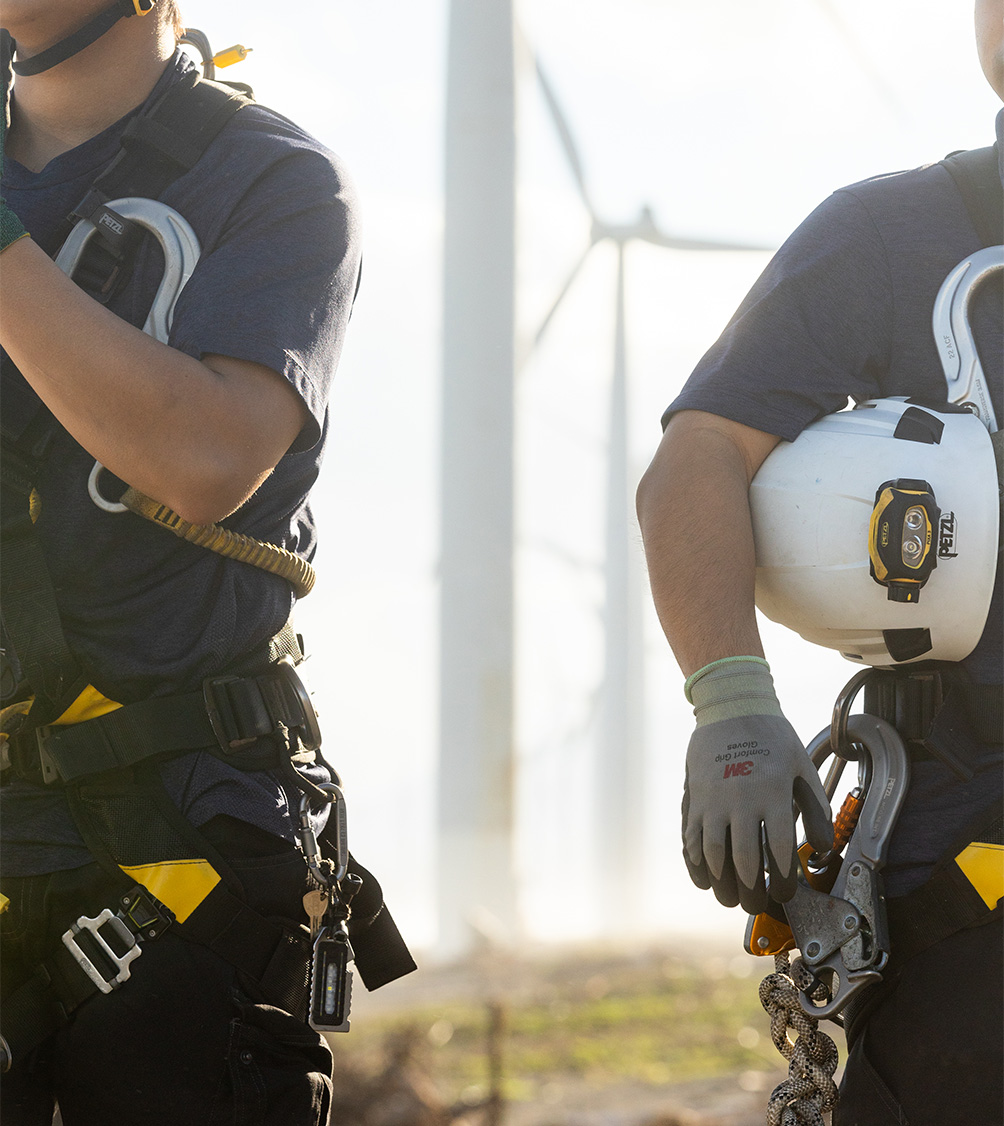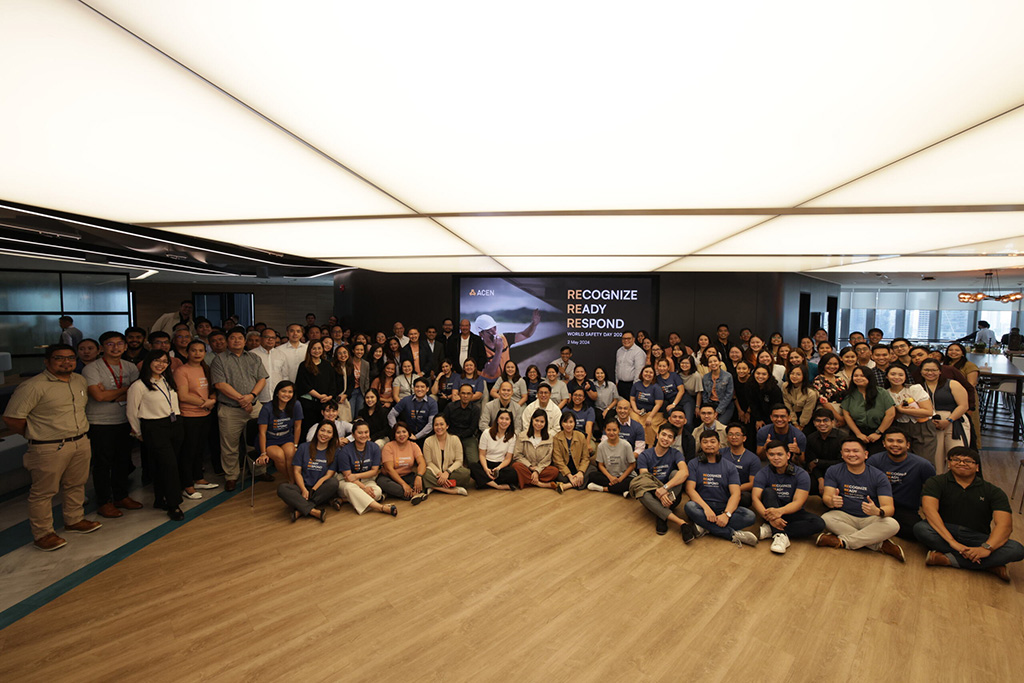Health and safety
In line with our Health, Safety, Security and Environment (HSSE) policy, we remain steadfast in our commitment to provide a safe workplace for our personnel. We adhere to the highest level of standards in terms of labor practices, including occupational health and safety
(H&S). We align with local laws and global best practices, including implementing an HSSE management system, setting clear targets and collaborating with employees, partners and contractors to build a strong safety culture across the organization.
The HSSE policy is overseen by our chief risk officer who represents health and safety at the executive level. At the corporate level, the HSSE team manages health, and safety matters and works with H&S officers at the project level to embed health and safety practices from development until operations.

As we drive our renewables agenda forward, we prioritize the health and safety of our employees at the core of our business.
Hazard identification and risk assessment
We implement a risk management process to identify, assess and prioritize health and safety risks on all sites, from projects which are under development to operating projects, to minimize probability or impact of potential incidents. The risk assessment is carried as early as during the development phase. In addition, our contractors are required to undergo a prequalification process aligned with ACEN’s safety rules, policies and workplace procedures.
Incident management
Our Incident Management System (IMS) provides a structured approach in responding to any kind of emergency that has impact on people, asset, community and environment. The HSSE and Risk team in the head office oversees the process and ensures its effectiveness.
In 2024, a number of employees took the courses on IMS 100, IMS 200 and IMS 300, covering topics such as the IMS overview, its application to the company, its leadership and management system, to ensure the effectiveness of the implementation of the MS. To provide a structured and timely approach for reporting, investigating and managing HSSE incidents, we have an incident reporting process and tool that applies to all locations where ACEN has operational and development activities and covers staff, contractors, vendors, subcontractors and third-party incidents. Through the standardized procedures, all incidents are reported in line with local regulations and industry best practices, and that appropriate level of investigation is conducted to prevent recurrence of incident.
Safety training hours in 2024
43,176
We require all incidents to be logged in our Automated Incident Reporting System (AIRS) within 24 hours of the incident occurring, followed by internal and external notification and incident investigation and review.
To ensure that similar incidents are prevented in the future, learnings from incident (LFI) are shared and learning sessions are also conducted regularly. We also adopt an incident command system to facilitate smooth coordination with external parties, including government agencies, for emergency response or incident management. We deploy incident commanders to ensure incident safety on-site and to communicate relevant information to stakeholders following the necessary response procedures for incidents and emergencies.
We utilize e-learning modules to cascade trainings on permit-to-work, effective intervention and risk management. Health and safety reorientations are also held yearly for all employees. In all of our project sites and operating plants, safety trainings are conducted regularly. In 2024, we organized a total of 43,176 safety training hours, more than double the previous year’s total of 20,106 hours. Our training sessions were attended by employees and contractors from our development teams, operations teams and head office.
As part of our intention to continuously collaborate with partners and contractors in advocating occupational health and safety, a whole day workshop was held last October with three of the biggest contractors of our plant operations. This was a follow through of the HSSE Leaders Contractor’s Forum held in 2023 wherein twenty key contractors were engaged on ACEN’s Contractor Health and Safety Standards.

We celebrated the 2024 World Safety Day with the theme, ‘Recognize, Ready and Respond’ in line with the global campaign of the International Labor Organization (ILO), which is “ensuring safety and health at work in a changing climate.”
Health and
safety certification
100% of our operational sites in the Philippines are certified under ISO 45001:2018 (Occupational Health and Safety), which demonstrates the organization’s capability to address the specific health and safety risks of its operational activities.
The certification is a testament of ACEN meeting global standards on preventing work-related injuries, illnesses and fatalities, as well as improving occupational health and safety performance through proactive management and continual improvement. This includes measures to ensure compliance with legal requirements, promote worker participation and consultation, and provide resources and training to support a safe working environment. Internal and external audits are periodically conducted to evaluate the performance and compliance of these sites in reference to the ISO standards.
In addition to our ISO certification, several of our Philippine plants have been recognized for their excellent health and safety performance. North Luzon Renewables and NorthWind were awarded by the Safety Organization of the Philippines, Inc. (SOPI) for achieving 1.75 million safe man-hours and 753 thousand safe man-hours, respectively, since 2020. Safety & Health Association of the Philippine Energy Sector, Inc. (SHAPES) awarded North Luzon Renewables, NorthWind, Pagudpud Wind and Cagayan North Solar for attaining zero lost time incidents in 2024.
Certification in all operational sites in the Philippines
ISO 45001:2018
Safe man-hours
20.3 million
2024 targets
and performance
As part of our commitment to continuously improve in our health and safety performance, we have established both lagging and leading safety indicators in 2024. To help ensure that we have the capacities in our operating and project sites, leading indicators such as training sessions, toolbox talks, management field visits, hazard and near-miss reporting, action close-out rate, participation rate in safety meetings are regularly tracked, analyzed for trends, and evaluated for its effectiveness in shaping a positive safety culture. These are on top of the lagging indicators such as zero fatalities and lost-time injuries and total recordable cases reduction targets.
The monthly performance results are also presented to management to monitor progress and discuss strategies to address repeat incidents, further mitigate health and safety risks for high risk work activities and enhance health and safety protocols, among others.
While we had zero employee and contractor fatalities, unfortunately, there were two motor vehicle crashes involving contractor personnel that resulted to four third-party fatalities. We have conducted extensive investigations with all parties involved to gather all necessary information and develop detailed incident reports, conducted root cause analysis and created corrective action plans identifying the controls to be implemented for each identified problem area.

We conducted more management field visits and safety meetings in 2024, driving higher hazard reporting and exceeding internal targets.
Part of the corrective actions implemented include defensive driving training, strengthening of contractor protocols on fatigue management and journey planning. Similarly, while there were zero employee losttime injuries (LTI), a total of five contractor LTIs were recorded during the same period. Each incident was comprehensively investigated, and additional control measures were put in place for identified gaps. Key learning points from the incident investigations were shared to relevant stakeholders.
Aside from measuring our safety performance through LTI and TRCF, we are employing the use of leading indicators which are preventive measures designed to proactively identifying hazards and establish adequate controls to avoid occurrence of serious incidents.
As of year-end, we have conducted more management field visits and safety meetings compared to the previous year and received higher engagement on hazards reported, exceeding internal targets.
Moving forward, we will prioritize contractor safety management, construction and road safety as well as development of a health and safety governance framework to further address health and safety risks.

